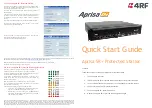
Theory of Operation:
Tone Remote Control Board
6881086C22-B
25
Detailed Description
Control Point Monitor
The ASTRO Spectra/Spectra Plus Consolette with the TRC option (L146)
supports Control Point Monitor as defined by the FCC. The local Consolette
speaker will unmute for remote audio that is being passed from the remote
device to the Consolette to be transmitted. When the local microphone is
keyed, the local speaker will be muted to voice audio. In addition, audio from
the local microphone that is to be transmitted by the Consolette is routed, via
the wireline interface, to the remote device. (This is not needed for FCC
Control Point Monitor and can be disabled by S100-2.)
When the ASTRO Spectra/Spectra Plus Consolette with the TRC option is
being used by both a local and a remote user at the same time, situations arise
in which one user has priority over the other. The following cases describe the
effect of dual interaction:
•
If the remote user performs a push-to-talk (PTT) while the local user is
already keyed, the remote user’s audio will be transmitted with the
encryption state that the local user has selected. This is only the case if
the remote user requested a PTT on the same channel that was selected
by the local user. If the remote user requested a PTT on a different
channel than what was selected by the local user, the Consolette will
dekey and a “bad” alert tone will be heard by both users until both PTTs
are released.
•
If the remote user attempts to change channels while the local user is
keyed, the Consolette will dekey and a “bad” alert tone will be heard until
the local user releases the PTT.
•
All attempts by the remote user to change the state of encryption are
ignored if the local user is already keyed.
•
If the local user performs a PTT while the remote user is already keyed,
the local user’s audio will be transmitted on the channel that the remote
user has selected with the encryption state that the remote user has
selected.
•
If the local user attempts to either change channels or the state of
encryption while the remote user is keyed, the Consolette will dekey and a
“bad” alert tone will be heard until the remote user releases the PTT.
Receive Audio Path
Audio from the receiver, as well as the various tones produced from the mobile
(that is, keyfail tones and button-press “beeps”), are gated through the ASTRO
transceiver and sent to the TRC board via a ribbon cable that plugs into J1 pin
42 (DET_AUD). Audio coming from the transceiver should measure
approximately 300 mVrms.
DET_AUD from the ASTRO transceiver is always passed through U116 gate 2
(S100-1 is always OFF for the Consolette). Audio at U116 pin 14 should
measure approximately 90 Vrms. Receive audio then passes through the
muting gate (U116 gate 1), controlled by RX_MUTE. Receive audio muting is
controlled by the microprocessor (U123 pin 36), which toggles the RX_MUTE
output line. When HLGT is detected or an LPTT is in progress, the receiver
audio will be muted. This gate is also muted for a local PTT in order to block
ASTRO noise at the DET_AUD line from entering the wireline.
The audio is passed through buffer amplifier U105 op amp 3 and then notched
at the guard tone frequency (2175 Hz) by hybrid HY2 filter 1. This hybrid
Summary of Contents for ASTRO Digital Spectra
Page 1: ...ASTRO Spectra Spectra Plus Consolette Instruction Manual ...
Page 10: ...viii 6881086C22 B Notes ...
Page 14: ...xii 6881086C22 B Consolette Installation Guidelines Notes ...
Page 22: ...xx 6881086C22 B ASTRO Spectra Consolette Options Notes ...
Page 26: ...Introduction Options 4 6881086C22 B Notes ...
Page 40: ...Installation Remote Control Installation 18 6881086C22 B Notes ...
Page 72: ...Cable Diagrams Optional Cables 50 6881086C22 B Notes ...
Page 74: ...Diagrams and Parts Lists List of Schematics Boards and Parts Lists 52 6881086C22 B Notes ...
Page 84: ...62 6881086C22 B Notes ...
Page 106: ...84 6881086C22 B Notes ...
Page 110: ...88 6881086C22 B Appendix A Cross Patch Configuration Notes ...
















































